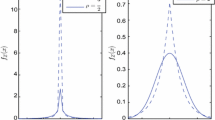Abstract
Novel infinite series based expressions for the bivariate Hoyt distribution are derived. More specifically, expressions for the joint probability density function (JPDF) and the joint cumulative distribution function (JCDF) of two Hoyt fading envelopes are derived, and proposed for use in performance analyses of dual-branch diversity receivers operating over correlated Hoyt fading channels. Using these reasonably simple and mathematically tractable expressions, we evaluate the performance of a dual-branch selection combining (SC) diversity receiver in terms of the outage probability (P out ) and the average bit error probability (ABEP) criteria. The ABEP performance is evaluated for binary differential phase-shift-keying (BDPSK) and binary non-coherent frequency-shift keying (BNFSK) modulation schemes.
Similar content being viewed by others
References
Hoyt R. S. (1947) Probability functions for the modulus and angle of the normal complex variate. Bell System Technical Journal 26: 318–359
Simon M. K., Alouini M. S. (2004) Digital communication over fading channels, 2nd edn. Wiley, New York
Radaydeh R. M. (2007) Average error performance of M-ary modulation schemes in Nakagami-q (Hoyt) fading channels. IEEE Communications Letters 11(3): 255–257
Youssef N., Wang C.-X., Patzold M. (2005) A study on the second order statistics of Nakagami-Hoyt mobile fading channels. IEEE Transactions on Vehicular Technology 54(4): 1259–1265
Youssef N., Elbahri W., Patzold M., Elasmi M. (2005) On the crossing statistics of phase processes and random FM noise in Nakagami-q mobile fading channels. IEEE Transactions on Wireless Communications 4(1): 24–29
Baid A., Fadnavis H., Sahu P. R. (2008) Performance of a predetection EGC receiver in Hoyt fading channels for arbitrary number of branches. IEEE Communications Letters 12(9): 627–629
Fraidenraich G., Santos Filho J. C. S., Yacoub M. D. (2005) Second-order statistics of maximal-ratio and equal-gain combining in Hoyt fading. IEEE Communications Letters 9(1): 19–21
Trung, Q. D., Hyundong, S., & Een-Kee, H. (2007). Error probability of binary and M-ary signals with spatial diversity in Nakagami-q (Hoyt) fading channels. EURASIP Journal on Wireless Communications and Networking, Vol. 2007, Article ID 53742, 8 pages. doi:10.1155/2007/53742.
Tan C. C., Beaulieu N. C. (1997) Infinite series representations of the bivariate Rayleigh and Nakagami-m distributions. IEEE Transactions on Communications 45: 1159–1161
Zogas D. A., Karagiannidis G. K. (2005) Infinite-series representations associated with the bivariate Rician distribution and their applications. IEEE Transactions on Communications 53(11): 1790–1794
De Souza, R. A. A., & Yacoub M. D. (2009). Maximal-ratio and equal-gain combining in Hoyt (Nakagami-q) fading. ftp://lenst.det.unifi.it/pub/LenLar/proceedings/2009/vtc09/DATA/02-03-05.PDF
De Souza, R. A. A., & Yacoub, M. D. (2009). Bivariate Nakagami-q (Hoyt) distribution. In Proceedings of IEEE ICC 2009 (pp. 1–5). Dresden, June 14–18, 2009.
Mendes J. R., Yacoub M. D., Fraidenraich G. (2006) Closed-form generalized power correlation coefficient of the Hoyt fading signal. IEEE Communications Letters 10(2): 94–96
Abramowitz, M., & Stegun, I. A. (1972). Modified Bessel functions I and K, §96. In Handbook of mathematical functions with formulas, graphs, and mathematical tables, 9th printing. New York: Dover
Sagias N. C., Karagiannidis G. K. (2005) Gaussian class multivariate Weibull distributions: Theory and applications in fading channels. IEEE Transactions on Information Theory 51(10): 3608–3619
Sagias, N. C., Karagiannidis, G. K., Bithas, P. S., & Mathiopoulos, P. T. (2005). On the correlated Webull fading model and its applications. In 62nd Vechicular technical conference, 25–28 September (Vol. 4, pp. 2149–2153).
Sagias N. C., Zogas D. A., Karagiannidis G. K. (2005) Selection diversity receivers over nonidentical Weibull fading channels. IEEE Transactions on Vehicular Technology 54(6): 2146–2151
Karagiannidis G. K., Zogas D. A., Kotsopoulos S. A. (2003) On the multivariate Nakagami-m distribution with exponential correlation. IEEE Transactions on Communications 51(8): 1240–1244
http://reference.wolfram.com/mathematica/tutorial/NIntegrateIntegrationStrategies.html.
Author information
Authors and Affiliations
Corresponding author
Rights and permissions
About this article
Cite this article
Bandjur, D.V., Bandjur, M.V. & Stefanovic, M.C. A New Approach to Bivariate Hoyt Distribution and its Application in Performance Analysis of Dual-Diversity Receivers. Wireless Pers Commun 63, 601–612 (2012). https://doi.org/10.1007/s11277-010-0153-y
Published:
Issue Date:
DOI: https://doi.org/10.1007/s11277-010-0153-y




